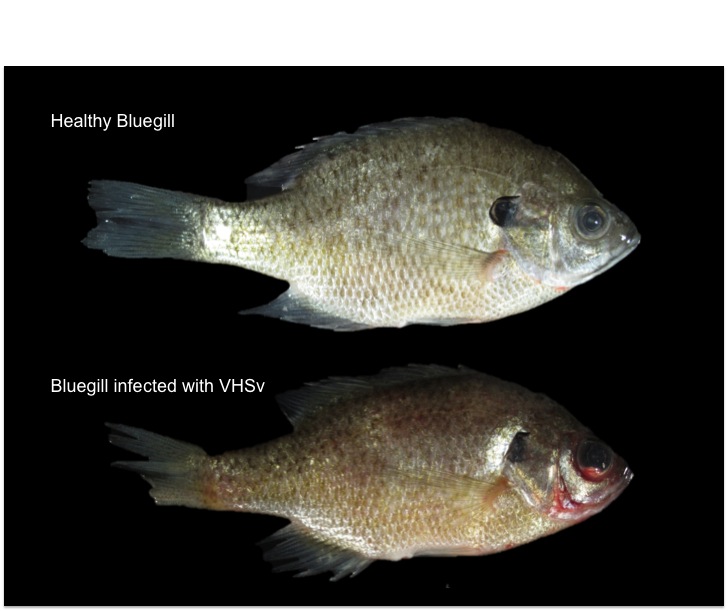Viral hemorrhagic septicemia (VHS) affects 34 species of fish, including walleye and bass. Its emergence has resulted in large-scale mass mortality events throughout the eastern Great Lakes and cost millions of dollars in management efforts. The virus is considered to be the most significant freshwater fish health threat in the world and has a history of large-scale fish kills. It is transmitted fish-to-fish from close contact of contaminated water or reproduction. More about VHS.
MAISRC findings
- Developed a new diagnostic assay that is 1,000 times more sensitive, lowered turn-around time from 28 days to 4 hours, and reduced cost by 40% compared to the previous test
- Annually sampled about 35 high-priority bodies of water for early detection
- Created and offered training programs for veterinarians, aquaculture producers, and field biologists to effectively identify and respond to a VHS outbreak
- Developed risk management recommendations that have been implemented by the Minnesota DNR to prevent the introduction and spread of VHS
- Used predictive suitability models to show that conditions in the Great Lakes, and much of Minnesota, are still at risk for an outbreak of VHS
Research
Screening for VHS in Minnesota waters
From July 1, 2012 to June 30, 2014 a total of 4,552 fish from 36 bodies of water, eight of which were sampled each year, were negative for the virus. While Minnesota remains free of VHSV, the threats of introduction remain a concern for fish health managers. This study has informed future surveillance strategies, risk assessment, and improved confidence in current management approaches.
Led by Dr. Nicholas Phelps
About VHS
Description
As the name describes, the virus can cause internal and external bleeding which in severe cases leads to organ failure and death. However, it is important to note that clinical lesions can vary among susceptible species. For example, walleye can develop severe hemorrhagic lesions, while muskellunge appear fairly normal despite being highly susceptible to low levels of virus.
Life cycle
The strain of VHSV in the Great Lakes (VHSV-IVb) is particularly active in cool waters (5-20C) and can survive outside of the host at ideal temperatures (~10C) for weeks. The virus is transmitted fish-to-fish from close contact of contaminated water or reproduction. The virus can also be transmitted on the surface of the egg to be passed from parent to progeny.
Impacts
In the Great Lakes, 34 species of fish have been found positive from natural infections. This includes many of the popular game fish species such as Walleye, Muskellunge, Salmonids, and Bass. The reservoir species (e.g. maintains virus persistence in the environment) in the Great Lakes appears to be another invasive species, the Round Goby.
Distribution
VHSV has been confirmed in all of the Great Lakes, in some inland waters of Michigan (Budd Lake), New York (several finger lakes), and Wisconsin (Lake Winnebago). The virus has not been detected in inland waters of Minnesota, however Lake Superior is known to be infested.
How it spreads
The virus can spread from one location to another via direct fish/water movement (i.e. connected waters), transfer of infected fish (i.e. stocking, baitfish), and contaminated water and gear (i.e. boaters, anglers). Proactive measures to test fish to certify freedom of disease for live fish transfer has been an important management strategy limiting the spread of VHSV in the region.

